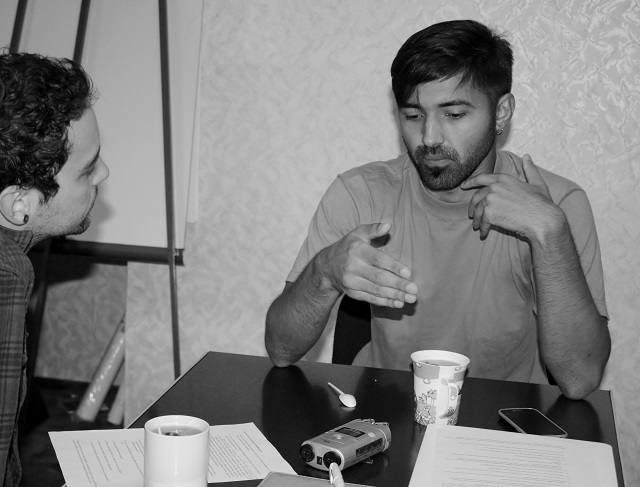
Ramin, why did you decide to become a photojournalist?
I studied journalism at the State University, but I never thought of becoming a photojournalist. I had been interested in photography since my first year at the university, I was doing photography, I was interested in public places, and during my last year of study I was offered to work as a photographer for a local newspaper. Although I had no photojournalism classes at the university, I accepted to work with that newspaper. Then the newspaper closed, and I still continued doing photography: I liked catching scenes from life, including what was happening around me. Now I am working with Timpul, but as a freelancer.
How competitive and developed do you find this sector in Moldova?
There is not much photojournalism in Moldova, and there is no school of photography. There were and still are some photojournalists, but not all of them work in the country. Moldova has no serious photojournalism or culture of the image.
In your opinion, what are the biggest challenges for a photographer?
Some people ask me why I make “ugly” photos, but by doing it I am trying to show the truth, things that I observe, and it is up to us to change a situation we don’t like.
In photography, of course you need training, education, but without a consumer for your products, you won’t manage a lot. We don’t have a photo industry or photo editors in Moldova. We need a foundation, other professions in the photo industry. We need to educate people in visual perception, so as to make them able to understand how to judge an image.
According to the media monitoring report produced by the Association of Independent Press (AIP), the phenomenon of manipulation through mass media in Moldova becomes increasingly dangerous, and in the end it is the public who gets to suffer. Sometimes, manipulation through mass media takes place by selecting videos, photos and captions to them. What is your view on this?
I’m not sure it is only in Moldova. Manipulation in the media is present in all Eastern countries. We don’t produce anything outside of Chisinau – the press is really centralized. There are some newspapers, but centralization is still a problem. We have some televisions that are like phantoms of one big company. We have journalism, but as an industry and a product I don’t find it satisfactory. I can´t call myself a loyal consumer of the national journalism, and I don’t watch TV. But I do believe that if somebody opened a new and professional TV station or newspaper, the audience would move to them.
Which of your photographs made you famous?
I didn’t know I was famous… I won some contests because my works showed something significant, and I want to capture things with just one shoot. I had been a photojournalist for one year when I received the Magnum Foundation Human Rights Fellowship. In those days, I was making photos of disabled people and their activities. I started a series about the butterfly disease and decided to send the photos to the contest. That scholarship was a serious impulse in my career.
You covered the events in Ukraine as well…
Yes, I stayed there for two weeks. It was immediately after the events in Odessa. I was not making any photo reports, but walking and trying to think about that situation and what it means for Ukrainians and for me.
What events in Moldova impressed you as a photographer?
Events are not the only things that can inspire a photographer… I’m working on some reports about villages now. I am not interested in the frame, but in the moments, including the environment. I don’t like shooting news.
How important is it to have formal training in this field? Can you learn photography by practicing it?
It depends on your personality. It is not necessary to study photography; you can learn it simply by attending some workshops. But it is important to learn from masters, somebody with experience.
What is the part of your profession that you like the most?
I like to observe, and now I’m mostly an observer. I keep ideas and develop them, transforming them into concepts. I sometimes take photos of places in Chisinau, because the city is transforming. When I see something I find interesting, I go and take a photo.
What do you think would be a perfect photograph look like?
A perfect photograph is an honest one, without too much technical stuff. First of all you need to capture … the feeling.
What do you think about new technologies? Are they affecting photojournalism or reviving it?
On the one hand, they offer more possibilities, but on the other hand… New technologies are affecting the entire media world; the biggest agencies show tendencies of using non-professional photos.
When you have hundreds of pictures, what criteria are you following to choose the best?
I try to choose the most representative of the place where I have been: I do a mental map and choose the best picture.
Who inspires you?
I like the works of some photographers, but I can’t say they are inspiring me. I’m inspired by the topics that I choose, by the things I see in the street or read in newspapers.
What is your opinion about the World Press Photo contest?
They choose from the pictures that they have, from the pictures that people send to them, not from the entire world…
Can you give some advice for those who want to become photojournalists?
Keep in mind that the frame of your photo is not a physical measure; it is a perception. So it is your eye that should take photos, not your camera.
Interview by Rubén Pulido (Spain)
volunteer for the Independent Journalism Center (IJC)












